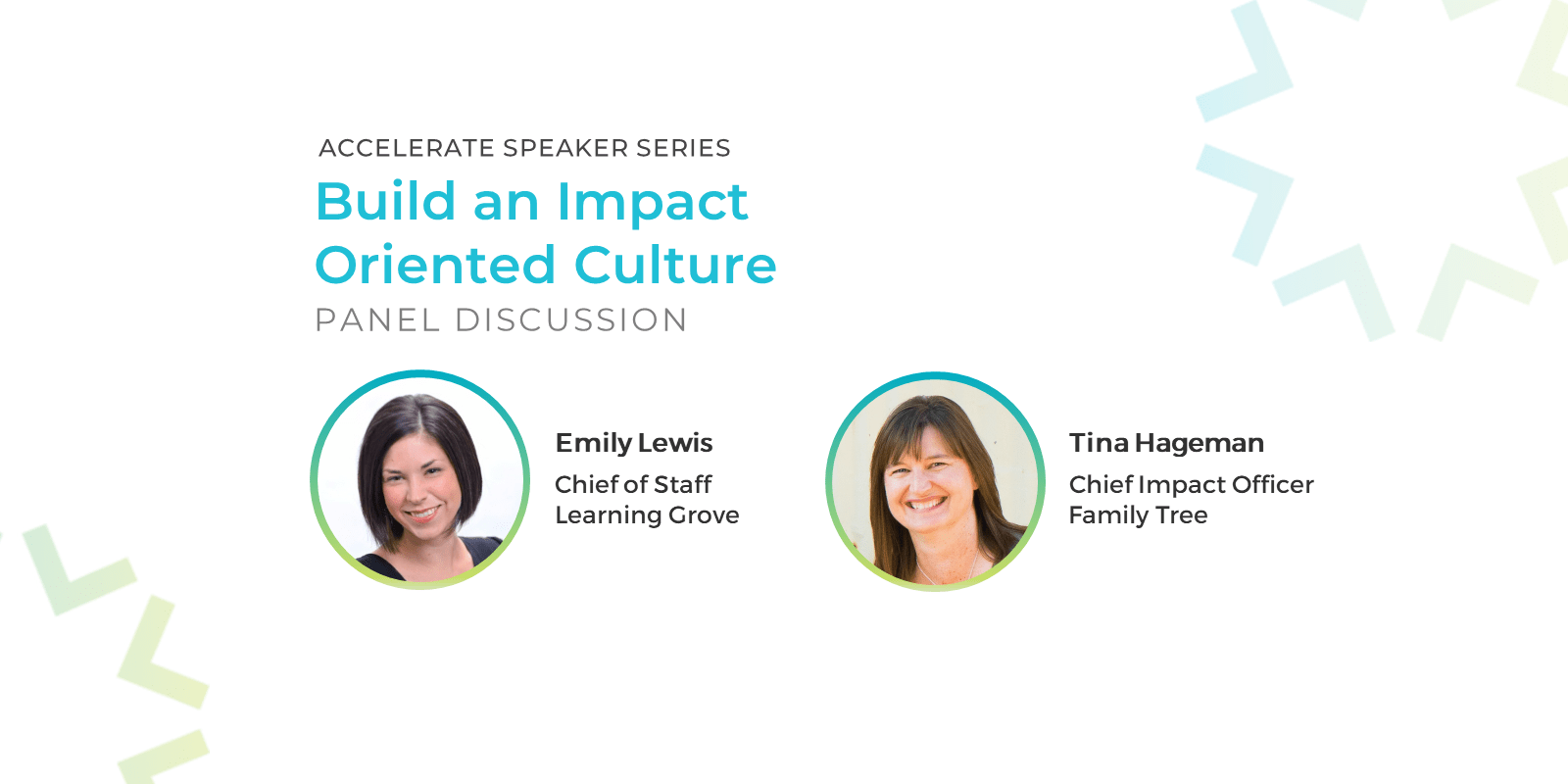Tina Hagman, Chief Impact Officer, Family Tree and Emily Lewis, Chief of Staff, Learning Grove spoke on our virtual panel, Build an Impact-Oriented Culture, with Cindy Eby, CEO and Kenzie Strong, VP of Impact Services at ResultsLab.
In this blog post, we share highlights from the panel around what it means for an organization to be impact-driven, common challenges, and how you can begin to develop action steps for your own organization.
To watch a recording of the panel discussion, you must be a member of ResultsLab’s Impact Collective. You can join the community here, and if you’re already a member, see the full recording here.
What is an Impact Driven Culture:
An impact driven culture starts with continuous improvement. It’s a culture that is open to using data for learning, and taking that to make both small and large-scale changes within an organization to ultimately improve its impact.
With an impact driven culture, an organization has a clear picture of the outcomes it seeks to achieve, and a clear picture of the work driving towards those outcomes.
3 Signals of a Strong Impact Driven Culture
- At any level of organization, anyone can answer what is the impact your organization is trying to achieve, and how is your organization working to achieve that.
- When new opportunities arise, organizations lean in on data and its Impact Strategy to assess if and how it should take an opportunity forward.
- Teams regularly hold space for data review and reflection.
Common Challenges:
Trying to create a shift in the way organizations operate to get teams to embrace data, and ensure everyone is aligned and onboard can be challenging. Here are a few of the challenges we heard about in this panel discussion that organizations face.
- Team buy-in: Having a mix of team members that feel overwhelmed by data or struggle to see the value, and others that are excited and bought in.
- Capacity: The competing needs of staff who often are responding to pressing client needs, while also trying to make time for data collection and analysis, and all the other tasks required in their role.
- Data overload: Filtering out data that isn’t being used, while trying to manage the desire to want more. Learning how to siphon down to what really matters.
Advice to Overcome Challenges:
How to shift the mindsets of team members who are not bought in:
- Dedicate time to individual outreach. Meet team members where they are and know that their capacity is stretched.
- Make data simple and engaging. Instead of sharing a spreadsheet of data, create visuals that elevate information that’s interesting to staff. Help connect the dots and show how data is impactful for the programs they work in, and the value data has specifically for their work.
- Break through common misconceptions of data. Frequently reinforce the idea that data can be numbers, but also refers to storytelling and making strategic decisions.
How to address capacity challenges:
- Create data tools that serve a dual purpose. Make tools that support data collection that also are useful for program delivery. This helps with workflow and helps people get the information they need.
- Have someone with a dedicated data role. Part of this person’s focus is to help connect the dots for teams. This person does the pre-work to provide different teams with the most relevant data to their roles and/or programs, and shares it in a way that is easy and actionable.
- Create a group of impact champions. Find invested data team members who can help coach and build their team’s data skills along the journey.
How to avoid collecting too much data that doesn’t get used:
- Create or revisit your impact strategy. When designing, or revising, include staff voice in the process to foster alignment and connection. Think about ways you can also bring in community voice to validate and understand your community’s perspective, and to work more aligned as an organization with communities
- Keep your impact strategy visible. Make your impact strategy accessible and top of mind for all team members. Revisit when key decisions need to be made.
- Ask, ‘what matters most’. Look at your existing data and asses where can you find value from the data you already have.
Ideas for Action:
Do a data audit of your organization: What do you want to measure and reconcile that with what you already are measuring. Can you identify gaps in data needs? Or opportunities to cut out some data collection efforts? Start with finding some wins for the team to get them excited about data.
Recommended Resources:
- Creating an Impact Strategy: Examples & Key Insights
- Impact Collective (*must be a member to access these resources)
- *Panel Recording
- *Data Audit Starter Kit – This resource is provided in our online Data for Impact: ACT™ Course, within the Capture Module. This toolkit walks you through step-by-step instructions on how to complete a data audit for your organization, with templates to support you along the way.

